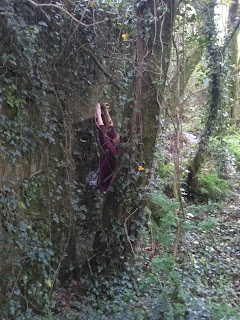Tsunami, 58. Lost Stones.
I went for my long walk this morning. It took longer than I expected, but I made ten kilometers. No marathon for me, but at least I'll move my body and bring my weight down to a more acceptable level.
My daughter went part of the way with me,
and I showed her the abandoned house in the wood, right next to the highway. On Saturday, when I had passed by, there was an older man in the open field next to it, burning refuse from cleaning out underbrush, in small piles. I asked him if he knew anything about the house. He told me that when the woodlands that stretched out behind him were fields, neighbors from the village of Isorna would bring up the oxen and stable them in there. The people would come and go during the week it would take to sow the fields in the spring. This way, they let the oxen rest, instead of making them walk both ways and pull the plow. According to him, this was in his grandfather's time, so it was probably a stable about a hundred years ago.
Today, my nimble daughter jumped down from the wall that keeps the field next to the house level against erosion to the woods below. She found carving in the lintel and ran her fingers over the mossy stone. The year was 1796. She looked inside, and saw a round stone that looked like it was part of a mill. So, we came away with the conclusion that it had been built as a mill, since there is a small brook running next to it. The highway behind it must have destroyed any other vestiges there had been. It must not have been profitable, since a little over a hundred years later it was abandoned and used as a temporary stable.
The land has been in the process of abandonment for many years. Proof of that is the lack of knowledge about a building, like this house, and cart tracks in the woods that the broom, gorse, brambles, and young trees have encroached upon. The other day, I took what looked like a short cut down to a village. The width was that of a cart track big enough to have taken an oxen cart. But the actual beaten path was narrow, and only fit a pair of feet. Along the way, there were signs of previous heavy usage, such as the groove in stone, where the metal rim of the old wooden wagon wheels ground down the stone. That doesn't happen in a couple of years, but over several generations. That track was once an important lane, probably leading, aside from the plots of land, to other villages. So many tracks have been lost, even when new ones were created.
Once upon a time, everyone went walking everywhere. I remember my mother telling me that she would walk to the village of Isorna, where I wandered today, just to go to the yearly festival there. People walked everywhere, and today's overgrown cart tracks were the highways of the villagers once. Not even so long ago. When I was born, a little over fifty years ago, paved roads were narrower than they are now, and cars were not that common. Most used dirt lanes and cart tracks as their daily streets. It's only in the last thirty or forty years that we have become more town and city centered. When she was four years old, we took our daughter for a walk in the woods. As she brushed against different branches, she would say, "Qué desastre!" What a disaster! Even living in a rural area, we now gravitate toward asphalt and cars, leaving dirt lanes to become overgrown and disappear.
Let's see if there are any other discoveries waiting out there.
Life continues.





What fun these discoveries.
ReplyDeleteThey definitely are!
Delete